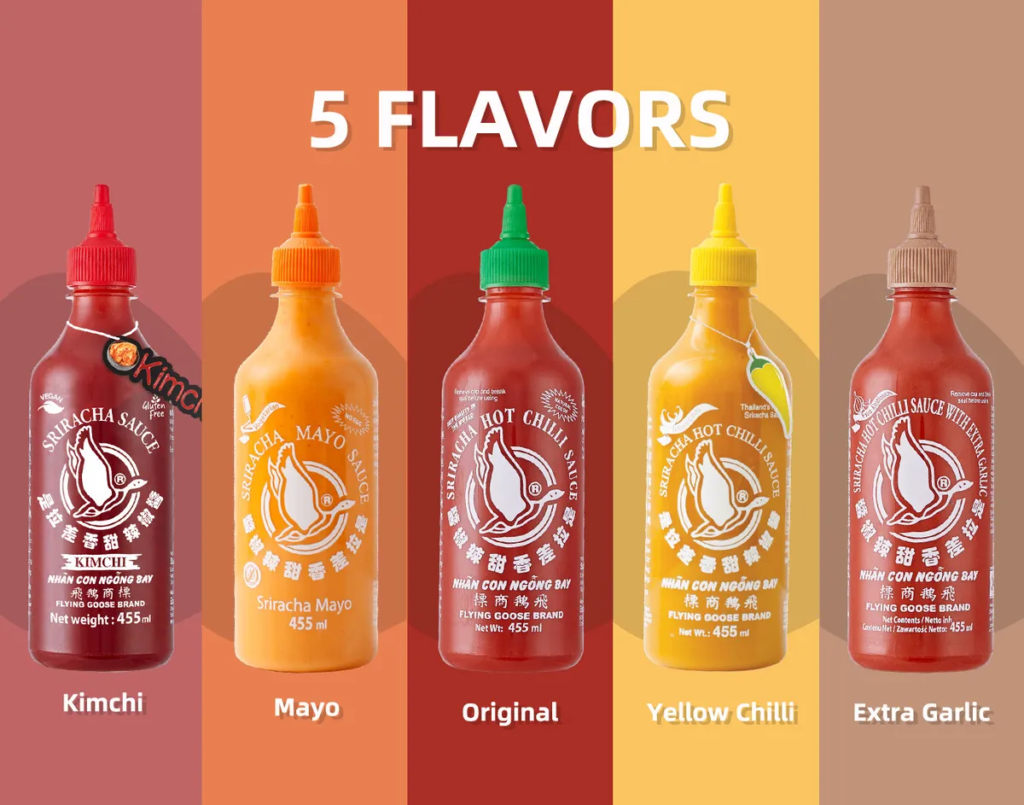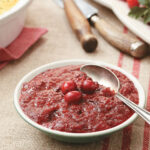The air is filled with the enticing smoky barbecue aroma, tempting our senses as we embark on a sizzling journey into the world of Sriracha barbecue. The fusion of Southeast Asian spiciness in Sriracha Sauce with a rich barbecue tradition creates a culinary symphony and a taste explosion. In this article, we will delve deep into the fascinating world of Sriracha barbecue, tracing its origins, understanding its flavor profile, exploring its role in barbecue recipes, and even uncovering the science behind its heat. So, barbecue enthusiasts, fasten your seatbelts and embark on this spicy adventure!
A Brief History of Sriracha Sauce
Sriracha's Origin in Thailand
Our journey begins in the coastal town of Sriracha, Thailand, the birthplace of the iconic Sriracha Sauce, also known as the “rooster sauce” due to the famous emblem on the bottle. In the early 20th century, a visionary named David Tran introduced this spicy chili sauce to the world. It initially was a staple in Thai cuisine, providing spiciness and garlic flavor to a variety of dishes.
Sriracha's Rise in the United States
The Sriracha craze crossed the seas to find a new home in the United States. Due to its unique blend of flavors, the popularity of this sauce skyrocketed. Today, it is not only a condiment but also a symbol of culinary innovation, making its way into kitchens and restaurants across the United States.
A Globally Beloved Condiment with Universal Appeal
The global appeal of Sriracha is undeniable. It has transcended cultural boundaries and can be found in pantries all over the world. Its distinctive heat and flavor make it a beloved condiment that has earned a place in countless recipes beyond its Thai origins.
Introduction to the Flavor of Sriracha
The Spiciness of Red Chili Peppers
At the core of Sriracha’s flavor is the spiciness of red chili peppers. These vibrant chilies are typically made from a variety known as “red Mexican chili,” renowned for its intense spiciness and bright red color. The chilies are carefully selected for their heat and flavor, forming the foundation of Sriracha Sauce. The addition of chili seeds in the sauce enhances the heat, providing a spicy kick that tantalizes the taste buds.
The Subtle Sweetness of Garlic and Sugar
To balance the fiery heat of the chili peppers, Sriracha incorporates the subtle sweetness of garlic and sugar. This is where the complexity of Sriracha’s flavor truly shines. Garlic not only contributes its unique savory taste but also adds to the sauce’s aroma.
Sugar, often in the form of granulated sugar or corn syrup, serves as a sweet contrast to the spiciness of the chili peppers. This sweetness is crucial for creating a harmonious flavor that makes Sriracha not only spicy but irresistibly delicious. Sugar also helps temper the heat, making the sauce suitable for a wider range of taste preferences.
The Rich Flavors of Vinegar and Salt
Two key ingredients that enhance the flavor of Sriracha are vinegar and salt. These elements provide a rich and salty balance to the sauce’s heat and sweetness. White vinegar, commonly used in Sriracha production, brings a bright acidity that enhances the overall taste.
The addition of salt serves multiple purposes. It not only acts as a natural preservative but also enhances the flavor in the sauce. The combination of vinegar and salt creates a dynamic flavor interaction that imparts a distinct richness to Sriracha.
Depth of Umami from Fermentation
One lesser-known but equally important aspect of Sriracha’s flavor is its fermentation process. The sauce undergoes natural fermentation that can last for several months. During this time, microorganisms break down the ingredients, releasing complex flavors and producing a rich umami taste that sets Sriracha chili sauce apart from other hot sauces.
Fermentation not only intensifies the sauce’s flavor but also imparts a unique aroma. The resulting umami adds complexity and richness, making Sriracha a versatile condiment suitable for a wide range of culinary applications.
Sriracha Sauce and Barbecue: Blending Spicy with Smoke
Imagine the fusion of Southeast Asian heat with the smoky barbecue ambiance. It’s a sensory awakening, creating an unforgettable culinary experience. The sizzle of meat on the grill, the wafting aroma of wood smoke, and the fiery taste of Sriracha combine to craft an enticing flavor symphony.
This fusion represents the merging of two vastly different culinary traditions. On one hand, you have the rich tradition of barbecue, with its slow-cooked, smoky meats that have satisfied generations. On the other hand, the bold and fiery flavor of Sriracha is deeply rooted in the vibrant Southeast Asian culinary landscape. It’s a culinary journey that transcends borders and traditions, bringing a unique and exciting twist to classic barbecue.
Sriracha Barbecue Sauce and Marinades
Sriracha (Sriracha) plays a pivotal role in the world of barbecue sauces and marinades. Barbecue enthusiasts have found that this spicy condiment can add depth of flavor, elevating their barbecue to a whole new level. When incorporated into rubs and marinades, Sriracha infuses its fiery characteristics into the meat, allowing the flavors to penetrate deeply.
As a marinade, Sriracha provides both heat and flavor for the meat to absorb during the marination process. Whether you’re preparing ribs, chicken, or seafood, adding Sriracha can take your barbecue game to new heights.
Enhancing Barbecue Sauces with Sriracha Sauce
Traditional barbecue sauces are known for their richness, smokiness, and sweetness. However, when Sriracha enters the scene, exciting transformations occur. Sriracha can be used as an ingredient to make homemade barbecue sauces or simply drizzled over your barbecue creations to add a spicy kick.
Incorporating Sriracha into barbecue sauce recipes allows for customization of the heat level to match personal preferences. Whether you prefer a mild flavor or an intense spiciness, Sriracha can be adjusted accordingly, giving you control over the spice-to-flavor ratio of your barbecue sauce.
Sriracha Sauce BBQ Recipes
Sriracha Glazed Ribs: Fiery Flavor for Traditional Barbecue
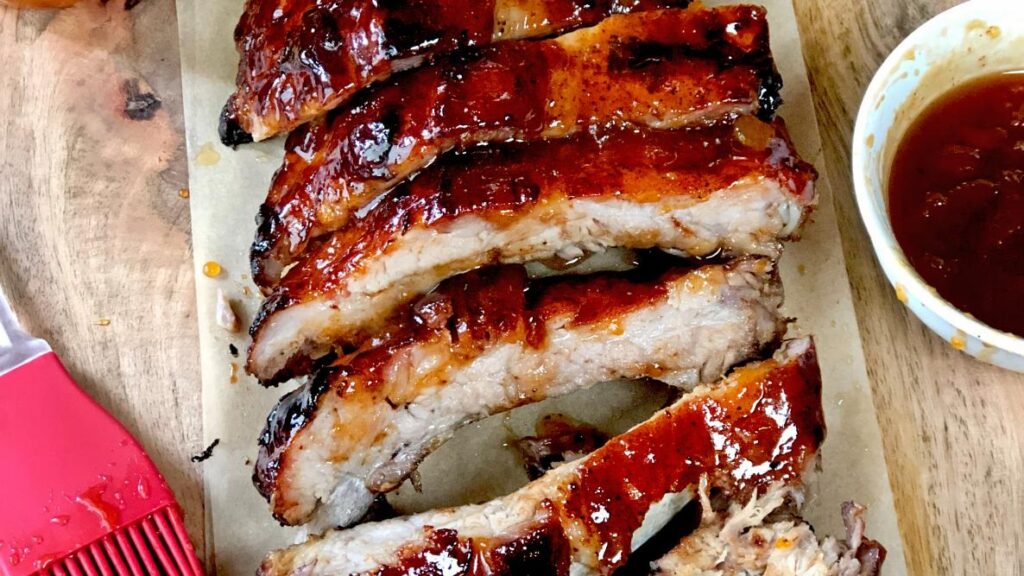
For those craving the fiery flavors of traditional barbecue, Sriracha glazed ribs are a must-try. These juicy ribs paired with spicy Sriracha Sauce take the flavor to a whole new level. To make this mouthwatering dish, start by marinating the ribs in a mixture of Sriracha, soy sauce, brown sugar, garlic, and ginger. Let the flavors meld for several hours or overnight.
Once the ribs have absorbed the spicy marinade, it’s time to start grilling. The high heat of the grill will char the meat and caramelize the Sriracha glaze, creating a thick, spicy, and smoky masterpiece. The finished ribs are tender, with a perfect balance of heat and sweetness, making them irresistible to barbecue enthusiasts. Here’s the specific recipe:
1) Ingredients:
For the Ribs:
2 racks of baby back ribs
Salt and pepper to taste
2 tablespoons olive oil
For the Sriracha Glaze:
1/2 cup Sriracha sauce
1/4 cup ketchup
1/4 cup brown sugar
2 tablespoons soy sauce
2 tablespoons apple cider vinegar
4 cloves garlic, minced
1 teaspoon grated fresh ginger
1/2 teaspoon smoked paprika (optional, for extra smokiness)
2) Instructions:
Prepare the Ribs:
Season both sides of the ribs generously with salt and pepper. Allow them to sit at room temperature for about 30 minutes while you prepare the grill. While at the same time, preheat the grill.
Grill the Ribs:
Brush the grill grates with olive oil to prevent sticking. Place the ribs, meaty side up, on the side of the grill with no direct heat (indirect heat). Close the grill lid and cook for about 2.5 to 3 hours. Maintain a temperature of around 225-250°F (107-121°C).
Prepare the Sriracha Glaze:
While the ribs are cooking, prepare the Sriracha glaze. In a saucepan, combine the Sriracha sauce, ketchup, brown sugar, soy sauce, apple cider vinegar, minced garlic, grated ginger, and smoked paprika (if using). Cook over low heat, stirring occasionally, until the mixture has thickened slightly. Remove from heat and set aside.
Glaze the Ribs:
After the ribs have cooked for about 2.5 to 3 hours and are tender, brush them generously with the Sriracha glaze. Make sure to coat both sides evenly. Allow the ribs to cook for an additional 10-15 minutes, continuing to baste them with the glaze and turning them occasionally to prevent burning.
Finish and Serve:
Once the ribs have a beautiful caramelized glaze and are cooked to your desired level of tenderness, remove them from the grill.
Let the ribs rest for a few minutes before slicing them into individual servings. This resting period allows the juices to redistribute, ensuring a juicy and tender bite.
Serve your Sriracha-glazed ribs with extra glaze on the side for dipping. Garnish with fresh chopped cilantro or green onions for a burst of freshness.
Spicy Sriracha Pork: Heat Up Your Sandwich
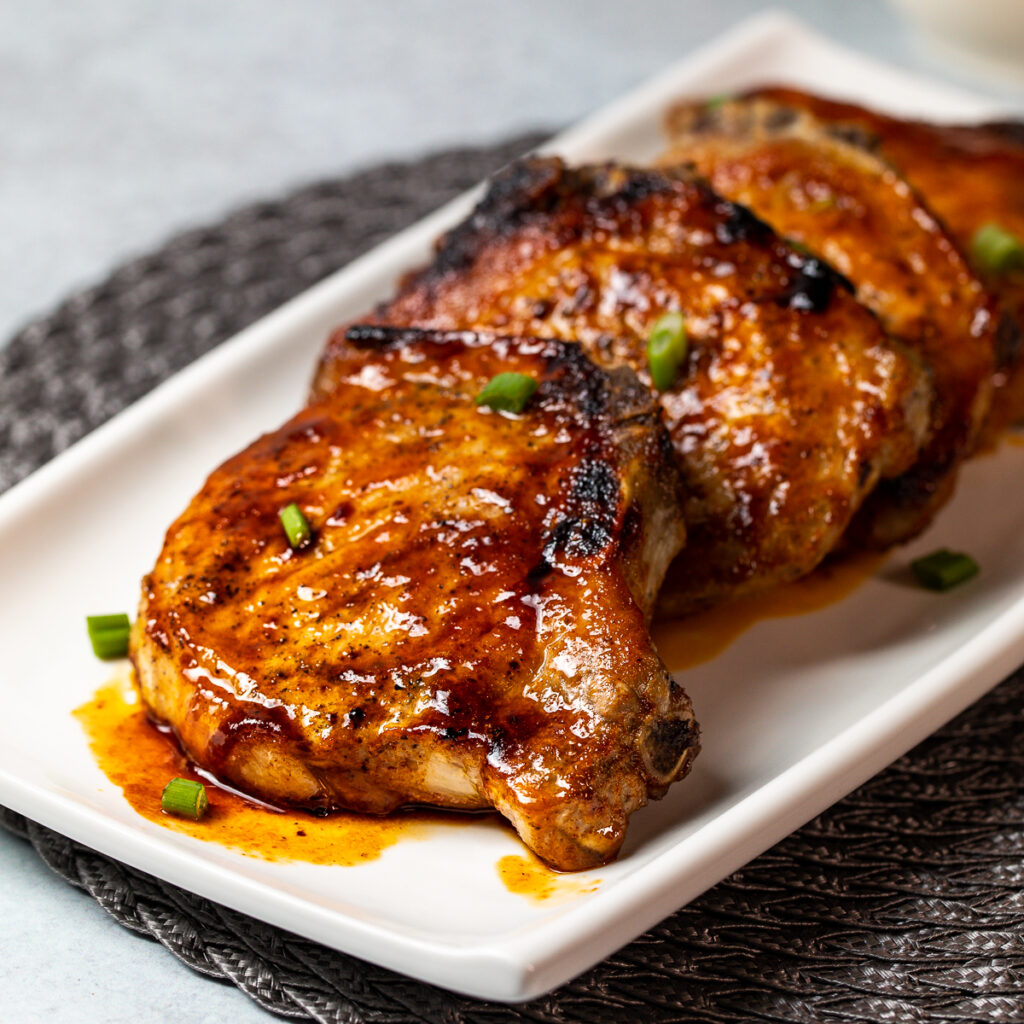
Pork sandwiches are a classic in barbecue, but when you inject Sriracha Sauce into them, they transform into a bold and fiery delight. The process begins with roasting pork shoulder, slowly cooking it until it’s tender enough to easily pull apart.
To add spiciness, mix Sriracha into the shredded pork and incorporate some barbecue sauce to enhance sweetness and complexity. This flavor combination creates a sandwich that is not only tender and smoky but also has a delightful kick of spiciness. Top it off with some coleslaw for a refreshing contrast that balances the heat, and then place it on soft bread. This satisfying meal will leave you craving for more.
Ingredients:
For the Pork:
3-4 pounds pork shoulder
Salt and pepper to taste
2 tablespoons olive oil
1 large onion, thinly sliced
4 cloves garlic, minced
1/2 cup chicken or vegetable broth
For the Sriracha BBQ Sauce:
1 cup ketchup
1/2 cup Sriracha sauce (adjust to taste for desired spiciness)
1/4 cup brown sugar
1/4 cup apple cider vinegar
2 tablespoons Worcestershire sauce
2 teaspoons smoked paprika
1 teaspoon ground cumin
1/2 teaspoon garlic powder
Salt and pepper to taste
For Serving:
Hamburger buns or sandwich rolls
Coleslaw (optional, for topping)
Instructions:
1) Preheat your oven to 325°F (163°C).
2) Season the pork shoulder or pork butt generously with salt and pepper.
3) In a large oven-safe Dutch oven or a deep roasting pan, heat the olive oil over medium-high heat. Sear the pork on all sides until it’s nicely browned, about 5-7 minutes per side. Remove the pork from the pan and set it aside.
4) In the same pan, add the sliced onions and minced garlic. Sauté them for about 3-5 minutes until they begin to soften and become fragrant.
5) Return the seared pork to the pan and add the chicken or vegetable broth. Cover the pan with a lid or aluminum foil.
Place the covered pan in the preheated oven and roast for 3.5 to 4 hours or until the pork is tender and easily pulls apart with a fork.
Prepare the Sriracha BBQ Sauce and serve:
1)In a medium saucepan, combine the ketchup, Sriracha sauce, brown sugar, apple cider vinegar, Worcestershire sauce, smoked paprika, ground cumin, garlic powder, salt, and pepper.
2)Heat the sauce over medium-low heat, stirring occasionally, until it simmers and the sugar has completely dissolved. Reduce the heat and let it simmer gently for 10-15 minutes to allow the flavors to meld. Adjust the Sriracha sauce quantity to achieve your desired level of spiciness.
Serve:
1)Pour the prepared Sriracha BBQ sauce over the pork. Mix well to coat the meat evenly with the spicy, flavorful sauce.
2)Toast the hamburger buns or sandwich rolls in a toaster or on a grill for added flavor and texture.
3)Place a generous portion of the spicy Sriracha pork onto each bun. Top with coleslaw if desired, which adds a refreshing and crunchy contrast to the spicy meat.
4)Close the sandwiches, and serve immediately.
Sriracha Barbecue Chicken Wings: Perfect Party Appetizers

When it comes to party appetizers, Sriracha barbecue chicken wings are the most popular choice. These wings are coated in a mouthwatering sauce made from Sriracha, honey, soy sauce, and a touch of lime juice. The result is a sweet, spicy, and rich glaze that perfectly coats the chicken wings.
As you grill or bake the chicken wings, the Sriracha glaze caramelizes, forming a thick and delicious coating. The wings become tender in high heat, with a perfect balance of smokiness and spiciness. Whether you serve them as appetizers or a main dish, these Sriracha barbecue chicken wings are sure to be the star of any gathering. Here’s the specific recipe:
Ingredients:
For the Chicken Wings:
2 pounds chicken wings, split into drumettes and flats
Salt and pepper to taste
2 tablespoons olive oil
For the Sriracha BBQ Sauce:
1/2 cup Sriracha sauce (adjust to taste for desired spiciness)
1/4 cup ketchup
1/4 cup brown sugar
2 tablespoons soy sauce
2 tablespoons apple cider vinegar
2 cloves garlic, minced
1 teaspoon grated fresh ginger
1/2 teaspoon smoked paprika (optional, for extra smokiness)
For Serving:
Fresh cilantro leaves (optional, for garnish)
Celery and carrot sticks
Ranch or blue cheese dressing (optional, for dipping)
Instructions:
Prepare the Chicken Wings:
1)Preheat your grill.
2)Pat the chicken wings dry with paper towels. This helps them crisp up in the grill.
3)In a large bowl, toss the chicken wings with salt, pepper, and olive oil until they are evenly coated.
4)Arrange the seasoned chicken wings on grill rack, ensuring they are spaced out to allow for even cooking.
5)Bake the chicken wings in the preheated grill for 20-30 minutes or until they are golden brown and crispy. You can turn them halfway through the cooking time for even crispiness.
Prepare the Sriracha BBQ Sauce:
1)While the chicken wings are baking, prepare the Sriracha BBQ sauce. In a saucepan, combine the Sriracha sauce, ketchup, brown sugar, soy sauce, apple cider vinegar, minced garlic, grated ginger, and smoked paprika (if using).
2)Heat the sauce over medium-low heat, stirring occasionally, until it simmers and the sugar has completely dissolved. Reduce the heat and let it simmer gently for 10-15 minutes to allow the flavors to meld. Adjust the Sriracha sauce quantity to achieve your desired level of spiciness.
Toss the Wings in Sriracha BBQ Sauce:
1)Once the chicken wings are cooked and crispy, remove them from the grill.
2)In a large mixing bowl, combine the baked chicken wings and the prepared Sriracha BBQ sauce. Toss the wings until they are thoroughly coated with the spicy, flavorful sauce.
Serve:
1)Transfer the Sriracha BBQ chicken wings to a serving platter.
2)Garnish with fresh cilantro leaves if desired, which add a burst of freshness.
3)Serve the wings hot with celery and carrot sticks for a crunchy contrast. You can also provide ranch or blue cheese dressing for dipping if you like.
Vegetarian Barbecue Delight: Sriracha Roasted Vegetables
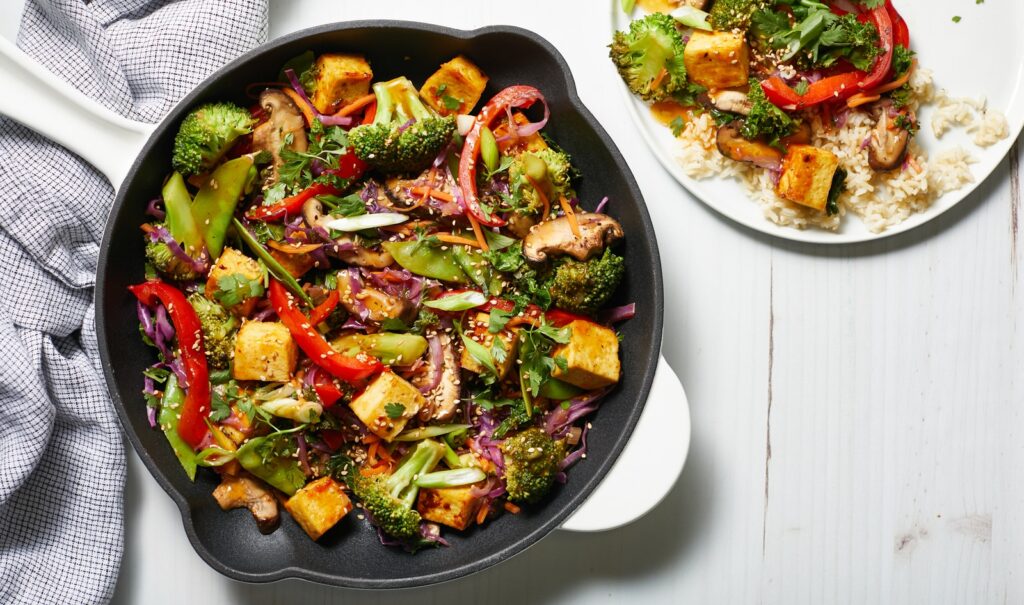
Even if you’re a vegetarian, you can still enjoy the excitement of Sriracha in barbecue dishes. Roasted vegetables marinated with Sriracha offer a flavorful and spicy meatless option.
To prepare this vegetarian delight, simply soak a variety of vegetables such as bell peppers, zucchini, mushrooms, and onions in a mixture of Sriracha, olive oil, garlic, and your choice of herbs and spices. Sriracha infuses the vegetables with its fiery flavor, while the grill imparts a smoky char and caramelized taste.
The result is a colorful array of roasted vegetables with complexity of flavor far beyond typical vegetarian barbecue fare. Serve them as a side dish or atop a bed of greens for a satisfying and spicy meal. Check out how to make them below.
Ingredients:
For the Sriracha Marinade:
1/4 cup Sriracha sauce (adjust to taste for desired spiciness)
1/4 cup olive oil
2 cloves garlic, minced
1 tablespoon soy sauce
1 tablespoon honey or maple syrup
1/2 teaspoon smoked paprika
Salt and pepper to taste
For the Grilled Vegetables:
Assorted vegetables of your choice (e.g., bell peppers, zucchini, mushrooms, onions, cherry tomatoes, asparagus)
Wooden skewers, soaked in water for 30 minutes (if using skewers)
Fresh cilantro or parsley leaves for garnish (optional)
Instructions:
Prepare the Sriracha Marinade:
In a bowl, whisk together the Sriracha sauce, olive oil, minced garlic, soy sauce, honey or maple syrup, smoked paprika, salt, and pepper. Adjust the Sriracha sauce quantity to achieve your desired level of spiciness. This marinade will be used to infuse the grilled vegetables with flavor and heat.
Prepare the Grilled Vegetables:
1)Preheat your grill to medium-high heat. Make sure the grates are clean and well-oiled to prevent sticking.
2)While the grill is heating up, prepare the vegetables. Wash and cut them into grill-friendly sizes. For example, you can cut bell peppers into strips, slice zucchini into rounds, and leave cherry tomatoes on the vine.
3)If using wooden skewers, thread the prepared vegetables onto the soaked skewers, alternating the types of vegetables for a colorful presentation.
4)Brush the vegetables generously with the Sriracha marinade, ensuring that each piece is well-coated. Reserve some marinade for basting during grilling.
Grill the Vegetables:
1)Place the marinated vegetable skewers or loose vegetables directly onto the preheated grill.
2)Grill the vegetables for 8-12 minutes, turning occasionally and basting with the reserved Sriracha marinade. The cooking time may vary depending on the thickness of the vegetables and your desired level of char and tenderness.
3)The vegetables are ready when they are tender and have grill marks, indicating that they are slightly caramelized and smoky.
Serve:
1)Remove the grilled vegetables from the grill and transfer them to a serving platter.
2)Garnish with fresh cilantro or parsley leaves for a burst of freshness and color if desired.
3)Serve the Sriracha-infused grilled vegetables as a flavorful and spicy side dish. They pair wonderfully with rice, quinoa, or even as a topping for grilled flatbreads. Enjoy this vegetarian BBQ delight that’s bursting with flavor and heat!
The Science Behind the Spice
To truly understand the science behind the spice in Sriracha, we must first delve into the role of capsaicin. Capsaicin is a fiery compound found in chili peppers that generates intense heat, making our taste buds tingle and our mouths feel vibrant.
When capsaicin comes into contact with our taste receptors, particularly the transient receptor potential vanilloid 1 (TRPV1) receptor, it triggers a series of events that lead to the sensation of heat and pain. This activation results in the release of neurotransmitters, including substance P, which conveys the sensation of heat to the brain. Interestingly, our brains interpret this “heat” as a pleasurable, enjoyable sensation, which is why many people enjoy the fiery heat of Sriracha and other spicy foods.
The surge in endorphins produced after consuming capsaicin is often referred to as “chili euphoria.” It’s a natural mood-enhancing effect that can bring feelings of elation and satisfaction. This is why spicy foods like Sriracha are often craved by those who enjoy this sensation.
How Sriracha Chili Compares to Other Peppers
The spiciness of Sriracha is typically measured using the Scoville Heat Scale, which quantifies the heat of chili peppers and spicy foods. Sriracha generally falls in the range of 1,000 to 2,500 Scoville Heat Units (SHU), depending on the specific brand and batch. In the grand scheme of things, Sriracha chili’s spiciness is similar to that of Mexican chili peppers, which typically range from 2,500 to 8,000 SHU.
Compared to some of the world’s hottest peppers, such as the Carolina Reaper or the Trinidad Moruga Scorpion pepper (which can exceed 1,000,000 SHU), Sriracha chili’s spiciness is relatively mild. However, its moderate heat makes it suitable for a broader audience, allowing people to enjoy the sensation of heat without overwhelming their taste buds.
Sriracha’s mild heat also makes it a versatile ingredient in the kitchen. You can use it to add delightful flavor to your dishes without overpowering other tastes. It’s this balance of heat and flavor that makes Sriracha a beloved condiment.
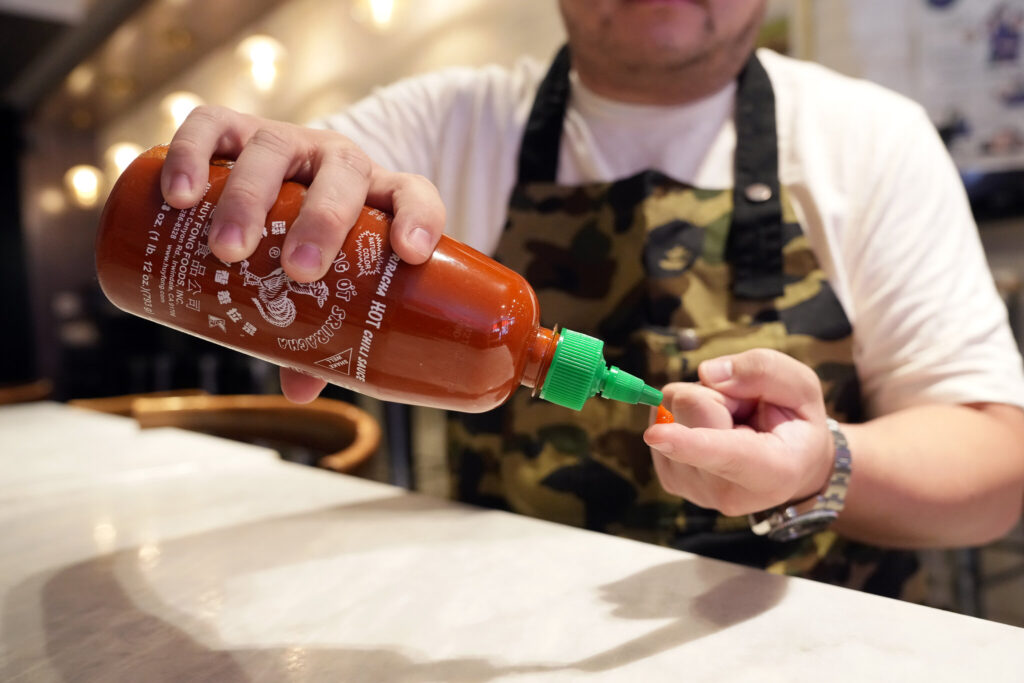
Conclusion: Sriracha Sauce Around the World
Sriracha enthusiasts, take note: Sriracha sauces come in various forms, offering a unique twist on the traditional recipe. From the classic Huy Fong Foods Sriracha to regional variations like Sriraja Panich, each sauce showcases distinct flavors and heat levels. Different regions have put their spin on Sriracha, infusing it with local ingredients and culinary traditions. Exploring these regional influences can open up new culinary horizons, allowing you to experience the diversity of Sriracha in exciting ways. Additionally, beyond the well-known brands, there are artisanal Sriracha producers with fascinating stories. Discovering these hidden gems can lead to exciting new taste experiences, providing you with a deeper appreciation for this beloved condiment’s global journey.

